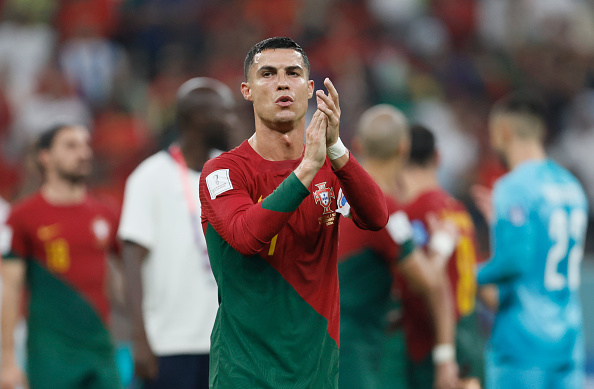Cristiano Ronaldo’s Farewell Could Take Him From the World Cup to Obscurity
The 37-year-old Portuguese star was hoping for a move to a major European club this winter. Instead, he may settle for riches—and irrelevance—in Saudi Arabia.
LUSAIL, Qatar—Cristiano Ronaldo has made the point, over and over, that he isn’t done with top-level soccer. But the reality emerging at this World Cup is that top-level soccer may be done with him.
Ronaldo, technically the most famous unemployed person currently in Qatar, was let go by Manchester United last month and cuts an increasingly peripheral figure for the Portuguese national team. On Tuesday, he was benched for the team’s 6-1 win over Switzerland in the round of 16, the first time he didn’t start a major-tournament match for his country since 2008.
This tournament no longer seems like just the final World Cup of a glittering career. It could mark Ronaldo’s de facto exit from the global stage altogether.
The most alarming part for him on Tuesday was that Portugal looked substantially better and more fluid without him. His replacement, the 21-year-old striker Gonçalo Ramos, scored a hat trick, overtaking Ronaldo’s tally for the tournament in the space of an hour. And still, fans inside Lusail Iconic Stadium chanted Ronaldo’s name, urging the manager to send him on.
When Ronaldo finally entered the game, met with the biggest roar of the night in the 73rd minute, it was in an unfamiliar new role for Portugal: luxury substitute. The closest he came to scoring was a late strike that ended up in the net, only to be ruled out for offside.
Now, even after the World Cup, his prospects for relevance are dimming.
Though Ronaldo desperately wants to continue playing, the list of places willing to pay him to do that is currently the shortest it’s ever been. As he took his place on the bench against Switzerland, he was mulling a contract offer not from a top team in Spain or Italy or even Major League Soccer, but from the Saudi Arabian club Al Nassr.
Unless another suitor emerges, just three months after a summer transfer window in which Ronaldo and his agent Jorge Mendes were unable to find a landing spot at a major club, Al Nassr appears to be in the lead for his signature. The switch would reportedly make Ronaldo the highest paid athlete in the world. It would also erase him from the top level of the game.
“What the press keep saying, the garbage, is that nobody wants me, which is completely wrong,” Ronaldo said in an explosive interview on British television on the eve of the tournament. “They continue to repeat that nobody wants Cristiano. How they don’t want a player who scored 32 goals last year, [including] with the national team?”
Somebody does want Cristiano. They just happen to play in a league few people pay any attention outside the Gulf—and Cristiano isn’t used to being ignored.
The only human with more than 500 million Instagram followers, he has spent two decades building himself into one of the most recognisable athletes ever to compete. But even his global appeal and immense marketing power no longer seem enough for major European clubs to justify the salary and special treatment demanded by a wilting 37-year-old. By the end of Ronaldo’s time in Manchester, United coach Erik ten Hag saw him only as a late-game option off the bench.
“The coach didn’t have respect for me,” Ronaldo said in the TV interview. “If you don’t have respect for me, I’m never going to have respect for you.”
In Saudi soccer, money and adulation were never going to be a problem. Al Nassr isn’t bound by the financial structures of European teams. The club’s longtime president was a grandson of the Kingdom’s founder, Ibn Saud. And the league, where foreign players are mostly unheralded journeymen, is prepared to roll out the red carpet for Ronaldo as if he were a visiting head of state.
The problem for Ronaldo is that Saudi soccer is basically invisible outside of the Gulf. While Manchester United might be the most famous team in any sport in the world, matches in Ronaldo’s potential new home garner no global attention. Plenty of superstars have made late-career stops in leagues outside the European heartland on their way to retirement, but the MLS and Japan’s J-League still generate more highlights than any soccer ever played in the Kingdom.
“I’ve worked in a lot of countries and everywhere you go, you see that in the youth, the quality is the same—in Holland, in Spain,” said Marco Koorman, a Dutch coach who works as a technical director in Saudi Arabia. “But the older they get, you see the level go down—especially in Saudi.”
Meanwhile, in Qatar, Ronaldo is less the inspirational leader of the Portuguese team, and more like a passenger. He scored once here against Ghana and then tried to claim another goal against Serbia, only for replays to show that the ball didn’t actually graze his hair. It was telling that when Portugal coach Fernando Santos fielded a second-choice lineup for the team’s final group-stage match and Ronaldo wasn’t one of the key players he rested.
He was, however, substituted. When Santos decided to remove him after 65 minutes, the Portuguese captain looked visibly frustrated, and then got into a spat with South Korea defender Cho Gue-Sung as he left the field. Cho told Ronaldo to get a move on. Ronaldo told Cho to be quiet.
Santos took a dim view of Ronaldo’s annoyance about being taken out of the game.
“I didn’t like it,” he said on Monday. “I really didn’t like it. But from that moment onwards everything is finished regarding that issue. These matters are resolved behind closed doors. It’s resolved.”
The bizarre sequence of events that put Ronaldo at odds with his own national team and on the road to soccer obscurity began with the best of intentions. When he moved to Manchester United from Juventus last year, it was billed as an emotional homecoming. The club that had first propelled him to superstardom during an unstoppable spell from 2003 to 2009 was bringing him back for a Michael Jordan-style last dance—one more shot at glory before calling it a career.
Instead, it wound up looking more like Jordan’s forgettable spell on the Washington Wizards.
Though Ronaldo was United’s top scorer last season, he was clearly diminished. The turn of pace was gone. He no longer marauded through defences the way United fans remembered. Even his touch was beginning to let him down.
This wasn’t the Ronaldo he wanted people to remember. Perhaps no player in soccer history has been as acutely aware of his own legacy during his own career. This is a man who built a museum in his hometown on Madeira to memorialise his accomplishments, and then built a new one because he decided the first wasn’t big enough. Even seemingly arcane records are deeply important to Ronaldo.
But he’s also aware of his own worth. And that is at the heart the dilemma facing Ronaldo as he maps out the coda to his career: Will he choose a club befitting his status as one of the best players in history—if he can find one—or will he pick a club matching his status as one of the best-paid athletes in history?
“Let’s be honest, [in] the last years, football changed,” Ronaldo said in the British TV interview. “I see football now as a business to be honest.”
 Copyright 2020, Dow Jones & Company, Inc. All Rights Reserved Worldwide. LEARN MORE
Copyright 2020, Dow Jones & Company, Inc. All Rights Reserved Worldwide. LEARN MORE
This stylish family home combines a classic palette and finishes with a flexible floorplan
Just 55 minutes from Sydney, make this your creative getaway located in the majestic Hawkesbury region.
As Paris makes its final preparations for the Olympic games, its residents are busy with their own—packing their suitcases, confirming their reservations, and getting out of town.
Worried about the hordes of crowds and overall chaos the Olympics could bring, Parisians are fleeing the city in droves and inundating resort cities around the country. Hotels and holiday rentals in some of France’s most popular vacation destinations—from the French Riviera in the south to the beaches of Normandy in the north—say they are expecting massive crowds this year in advance of the Olympics. The games will run from July 26-Aug. 1.
“It’s already a major holiday season for us, and beyond that, we have the Olympics,” says Stéphane Personeni, general manager of the Lily of the Valley hotel in Saint Tropez. “People began booking early this year.”
Personeni’s hotel typically has no issues filling its rooms each summer—by May of each year, the luxury hotel typically finds itself completely booked out for the months of July and August. But this year, the 53-room hotel began filling up for summer reservations in February.
“We told our regular guests that everything—hotels, apartments, villas—are going to be hard to find this summer,” Personeni says. His neighbours around Saint Tropez say they’re similarly booked up.
As of March, the online marketplace Gens de Confiance (“Trusted People”), saw a 50% increase in reservations from Parisians seeking vacation rentals outside the capital during the Olympics.
Already, August is a popular vacation time for the French. With a minimum of five weeks of vacation mandated by law, many decide to take the entire month off, renting out villas in beachside destinations for longer periods.
But beyond the typical August travel, the Olympics are having a real impact, says Bertille Marchal, a spokesperson for Gens de Confiance.
“We’ve seen nearly three times more reservations for the dates of the Olympics than the following two weeks,” Marchal says. “The increase is definitely linked to the Olympic Games.”

Getty Images
According to the site, the most sought-out vacation destinations are Morbihan and Loire-Atlantique, a seaside region in the northwest; le Var, a coastal area within the southeast of France along the Côte d’Azur; and the island of Corsica in the Mediterranean.
Meanwhile, the Olympics haven’t necessarily been a boon to foreign tourism in the country. Many tourists who might have otherwise come to France are avoiding it this year in favour of other European capitals. In Paris, demand for stays at high-end hotels has collapsed, with bookings down 50% in July compared to last year, according to UMIH Prestige, which represents hotels charging at least €800 ($865) a night for rooms.
Earlier this year, high-end restaurants and concierges said the Olympics might even be an opportunity to score a hard-get-seat at the city’s fine dining.
In the Occitanie region in southwest France, the overall number of reservations this summer hasn’t changed much from last year, says Vincent Gare, president of the regional tourism committee there.
“But looking further at the numbers, we do see an increase in the clientele coming from the Paris region,” Gare told Le Figaro, noting that the increase in reservations has fallen directly on the dates of the Olympic games.
Michel Barré, a retiree living in Paris’s Le Marais neighbourhood, is one of those opting for the beach rather than the opening ceremony. In January, he booked a stay in Normandy for two weeks.
“Even though it’s a major European capital, Paris is still a small city—it’s a massive effort to host all of these events,” Barré says. “The Olympics are going to be a mess.”
More than anything, he just wants some calm after an event-filled summer in Paris, which just before the Olympics experienced the drama of a snap election called by Macron.
“It’s been a hectic summer here,” he says.

AFP via Getty Images
Parisians—Barré included—feel that the city, by over-catering to its tourists, is driving out many residents.
Parts of the Seine—usually one of the most popular summertime hangout spots —have been closed off for weeks as the city installs bleachers and Olympics signage. In certain neighbourhoods, residents will need to scan a QR code with police to access their own apartments. And from the Olympics to Sept. 8, Paris is nearly doubling the price of transit tickets from €2.15 to €4 per ride.
The city’s clear willingness to capitalise on its tourists has motivated some residents to do the same. In March, the number of active Airbnb listings in Paris reached an all-time high as hosts rushed to list their apartments. Listings grew 40% from the same time last year, according to the company.
With their regular clients taking off, Parisian restaurants and merchants are complaining that business is down.
“Are there any Parisians left in Paris?” Alaine Fontaine, president of the restaurant industry association, told the radio station Franceinfo on Sunday. “For the last three weeks, there haven’t been any here.”
Still, for all the talk of those leaving, there are plenty who have decided to stick around.
Jay Swanson, an American expat and YouTuber, can’t imagine leaving during the Olympics—he secured his tickets to see ping pong and volleyball last year. He’s also less concerned about the crowds and road closures than others, having just put together a series of videos explaining how to navigate Paris during the games.
“It’s been 100 years since the Games came to Paris; when else will we get a chance to host the world like this?” Swanson says. “So many Parisians are leaving and tourism is down, so not only will it be quiet but the only people left will be here for a party.”
This stylish family home combines a classic palette and finishes with a flexible floorplan
Just 55 minutes from Sydney, make this your creative getaway located in the majestic Hawkesbury region.






















